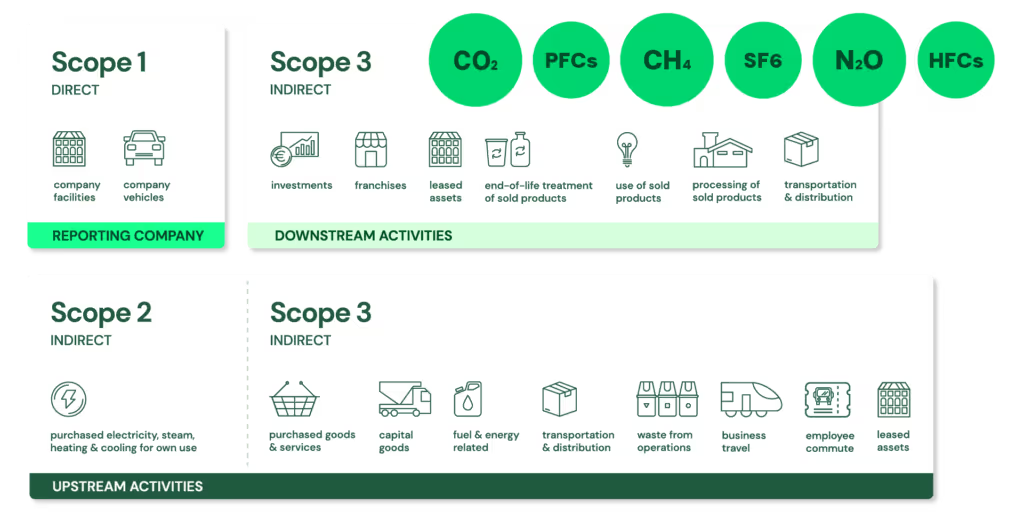Carbon tracking allows businesses to keep tabs on how much carbon they release into the atmosphere. Why does that matter? Picture this: increasingly, people are becoming aware of how our actions affect the environment. Governments are also tightening the screws with regulations to curb carbon emissions.
So, tracking your carbon footprint isn't just a good idea—it's becoming essential for businesses looking to stay ahead and do their part to protect the environment while safeguarding their future.
Carbon tracking is like a GPS guiding companies towards global sustainability goals. Knowing where you stand with carbon emissions can tailor your strategies to cut down, be more efficient, and become a sustainability leader. So, if you're ready to learn how to nail carbon tracking and steer your business towards data-driven decisions, you're in the right place. This article provides more details.
What is carbon tracking?

Carbon tracking is like keeping a diary of the carbon dioxide a company releases into the atmosphere. It's a systematic process where organisations record, measure, and study all the carbon emissions from their business activities, including manufacturing processes and employee travel.
Now, why bother with all this carbon tracking? Well, imagine you're on a journey to reduce your carbon footprint. You need a map to know where you're starting from and where you want to go. That's precisely what carbon tracking does. It helps companies set clear targets for reducing emissions and then track their progress towards those goals.
Plus, it's not just about keeping your scorecard clean. Carbon tracking is critical for telling the world and stakeholders how sustainable your business is. It's like showcasing your eco-credentials in a sustainability report, which is increasingly essential for building trust with customers, investors, and regulators alike.
Modern companies use carbon tracking software to manage their net-zero journey.
Key principles of carbon accounting
Understanding the fundamental principles of carbon accounting is like unlocking the secrets to mastering carbon tracking. First, it's all about knowing your emissions sources. You've got to identify every nook and cranny where carbon emissions are in your operations, whether from burning fuel in your factory or jet-setting for business meetings.
Next step: collecting data. Solid methods are needed to collect all the relevant information accurately. Just like in cooking, you need the right ingredients. That's where emission factors come in. They're like the recipe for calculating your carbon emissions.
Using the right emissions factors ensures your numbers are spot-on, giving you an accurate picture of your environmental impact. So, when it comes to carbon accounting, it's all about thoroughness, precision, and grounded in science to get it right.
Understanding emission scopes
Here is what you need to know to understand emission scopes:

Credit: Plan A
Why should all companies track their carbon emissions?
Here are the main reasons why all companies should track their carbon emissions:
Remember that sustainability isn't just about doing what's right; it's about driving innovation and long-term profitability in a rapidly changing business landscape.
Best practices for successful carbon tracking
To effectively track and reduce carbon emissions, companies must implement best practices that ensure accurate measurement and management of their footprints. This involves calculating direct emissions with precision and engaging the entire supply chain to account for indirect emissions. By following these practices, businesses can develop strategies that enhance sustainability and improve operational efficiency.
Effective calculation of carbon emissions
Companies can follow a straightforward formula that accounts for fuel consumption and emission factors to calculate carbon emissions accurately.
Example of calculation for company vehicles:
To demonstrate the calculation of carbon emissions from company vehicles, let's consider the following formula:
CO2 emissions (kg) = Fuel consumption (litres) x Emission factor (kg CO2/liter)
Suppose a company operates a diesel-powered truck that consumes 1,000 litres of diesel fuel over a period. The emission factor for diesel is approximately 2.68 kg CO₂ per litre.
Using the formula, CO2 emissions are 1,000 litres x 2.68 kg CO2/litre, or 2,680 kg CO2.
This calculation reveals that the truck emitted 2,680 kilograms of CO₂ during the measured period. The total emissions from the company's fleet can be determined by repeating this calculation for each vehicle. Then, companies can gain insights into their environmental impact and effectively develop strategies to reduce emissions.
Engaging the supply chain
Another best practice for successful carbon tracking is engaging the supply chain.
This step is crucial for tracking Scope 3 emissions, including all indirect emissions not covered in Scopes 1 and 2. Collaborating with suppliers remains crucial for companies with extensive supply chains to obtain accurate and thorough data.
Advancements in technology offer other promising solutions for tracking Scope 3 emissions. Carbon accounting platforms like Plan A provide a centralised system for collecting and analysing data from multiple suppliers. In contrast, with its immutable ledger system, blockchain technology promotes transparency and traceability throughout the supply chain, bolstering credibility in emissions reporting.
Carbon tracking has become essential for businesses aiming to stay competitive and meet growing environmental expectations. By systematically measuring and managing carbon emissions, companies can ensure compliance with regulations, build trust with consumers, and attract investment. Effective carbon tracking also offers a strategic advantage, enabling businesses to identify opportunities for cost savings and efficiency improvements. By adopting best practices, such as engaging the supply chain and accurately calculating emissions, companies can make informed decisions supporting sustainability and long-term profitability.

.jpg)



.jpg)

.avif)

